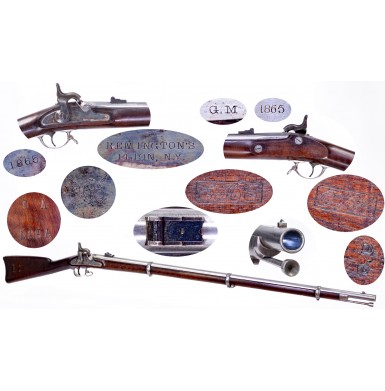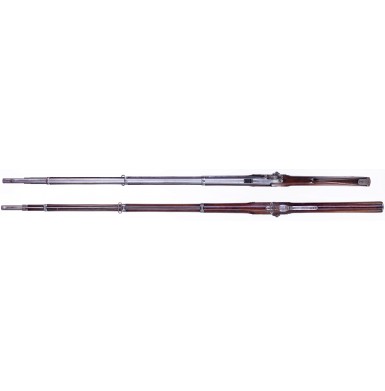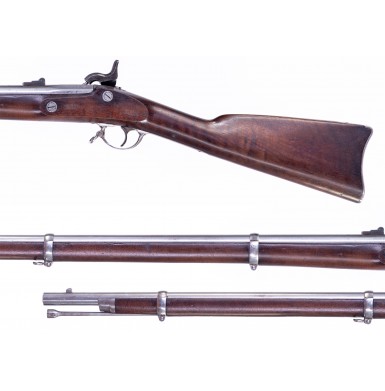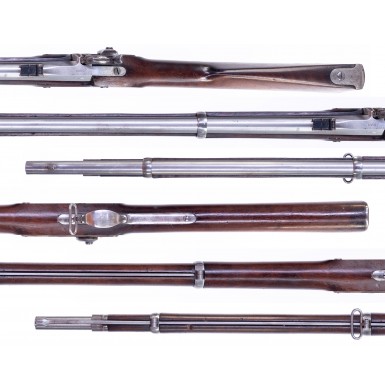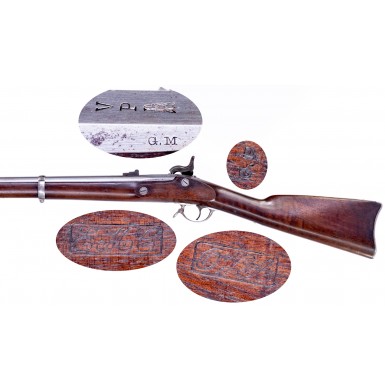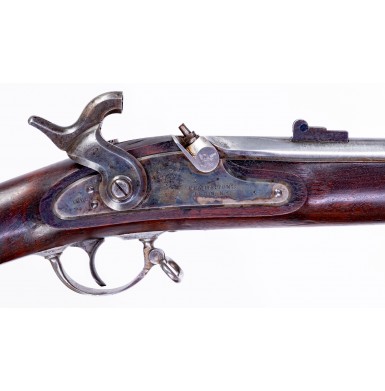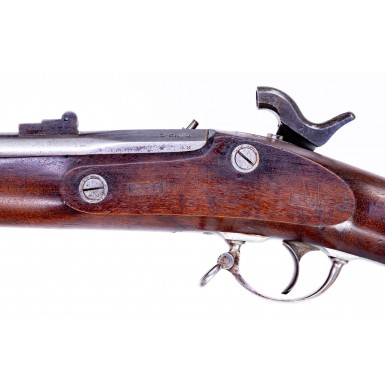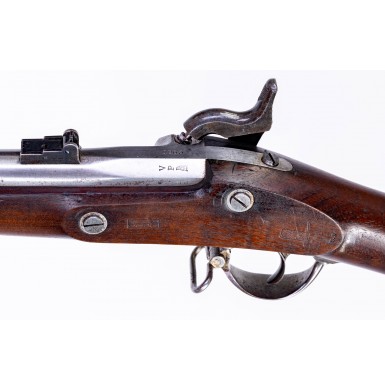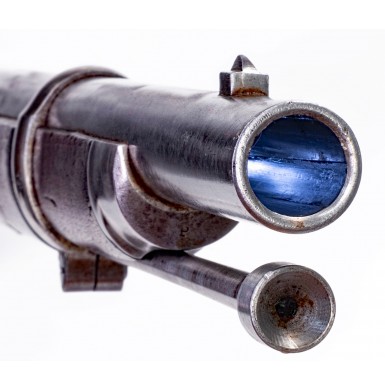Very Fine 1865 Dated Remington Contract US Model 1863 Rifle Musket
- Product Code: FLA-B225
- Availability: In Stock
-
$3,750.00
The Remington Arms Company of New York was one of America’s oldest and largest arms manufactories when the American Civil War erupted in April of 1861. The firm had a long history of being a contractor for the US Ordnance Department, starting in the mid-1840s when Eliphalet Remington Jr. purchased the equipment used to produce Jenks Breechloading Naval Carbines from the NP Ames Company and subsequently acquired a contract to produce a new, improved version of the Jenks Carbine which incorporated the Maynard automatic priming system. At about the same time, Eliphalet Jr. traveled to Cincinnati, OH to meet with John Griffiths, a major “western” gunmaker who had been contracted by the Ordnance Department to produce US Model 1841 “Mississippi Rifles”. The theory was this would provide a US arms contractor in a location closer to St. Louis, MO who could then ship arms to that facility much more cheaply than the makers in the northeastern United States. The contract proved to be too much for Griffiths who was not set up for assembly line production of interchangeable parts guns. As a result, Eliphalet Jr. offered to take over Griffiths’ contract and produce the guns for the Ordnance Department. In the summer of 1845 Eliphalet Jr. contacted the Ordnance Department and made his proposal to assume the Griffiths contract, for $12 per rifle. Eliphalet Jr. also proposed to make the rifle barrels of cast steel, which was a significant improvement over the iron barrels in current use. The Ordnance Department agreed to Eliphalet Jr.’s proposal, with the exception that they would pay $13 per rifle if the barrels were of cast steel. These would become the first steel barreled arms to be acquired by the Ordnance Department and the superiority of the cast steel process would motivate other contractors like Eli Whitney Jr. to pursue that technology and eventually even the National Armories, as the last of the Model 1841 Rifles produced at Harpers Ferry would include steel barrels as well.
Because of the two decades of relationship between Remington and the Ordnance Department, they were immediately approached to produce US Model 1861 Rifle Muskets when the war erupted. However, Remington was fully engaged with the production of revolvers for the Ordnance Department at that time, as well as the alteration and modification of Model 1841 Rifle Muskets for the State of New York, adapting them to accept primarily saber, as well as socket, bayonets. By the time Remington was in a position to start producing long arms again, the Ordnance Department had decided that they wanted a simplified version of the Harpers Ferry Model 1855 Rifle. These rifles, now known to collectors as the Remington “Zouave Rifle”. This contract was obtained by Eliphalet Jr.’s son Samuel Remington 6 August 1861 following his father’s death on July 15 of that year. Due to a number of issues related to factory expansion and acquisition of machinery, it would be April of 1863 before any of those rifles would be delivered and would place Remington squarely in the cross hairs of the Holt Owens Commission. After the testimony was concluded, the contract was reissued in August of 1862 and deliveries commenced in April of the following year.
In August of 1863, Remington was finally in a position to take on a contract to produce the standard arsenal model US rifle musket. At this point in time the pattern was no longer the Model 1861 but the newly developed Model 1863, which was based upon the improvements suggested by the Colt’s Patent Firearms Company that had been adopted as the US Special Model 1861 Rifle Musket. These guns have a somewhat simplified lockwork, based upon the British Enfield, had a flat bolster without a cleanout screw that had a more direct vent to the chamber and utilized screw tightening clamping bands to secure the barrel to the stock, rather than spring-retained solid bands. Other changes included the adoption of a straight-shank ramrod with a spoon in the stock to retain it, and the improved Model 1861 rear sight that had been developed by Elisha Root as an improvement over the 1858 pattern rear sight. The Model 1863 Rifle Muskets were contracted for at the rate of $16 each with the contract calling for the delivery of 20,000 stands of arms. Four months later, in December of 1863, an additional contract for 20,000 rifle muskets was entered into with the Ordnance Department, this time at $18 each with the new price appearing to be retroactive to the original contract as well.
Remington began their deliveries under the first contract in late June of 1865 and deliveries continued through March of 1866. This was a somewhat special circumstance, as nearly every other contractor to the Ordnance Department had the outstanding portions of their contracts cancelled with the end of the American Civil War. However, due to the power of New York’s senators, Remington was allowed to deliver all 40,000 guns that had been contracted for. The guns, however, were not all delivered at the full $18 contract price and were rated everything from 1st Class to 4th Class by the accepting officers and the prices that were paid for the guns were adjusted proportionally. While 1st Class guns were paid for at $18 each, those rated 2nd Class were accepted at the reduced rate of $17.90, those rated 2 ½ Class were accepted at $17.75, those rated 3rd Class were accepted at $17 and 4th Class arms were accepted at $16. Remington delivered 12,000 guns in 1864 and the balance in 1865 and 1866. Only 5,000 more would be delivered before Lee’s surrender at Appomattox, with the remainder of 23,000 guns delivered after the conclusion of the war, including 3,000 delivered in 1866. These guns were never issued for US military use and were rather quickly made available for sale as surplus. Many of the guns delivered by Remington would end up seeing use during the Franco Prussian War of 1869-1870, with some being resold by brokers like Schuyler, Hartley and Graham and others being sold by Remington themselves after reacquiring the guns from the Ordnance Department or on the open market. In particular Remington repurchased the first 1,000 .50RF Remington Split Breech Carbines that they had delivered to the Ordnance Department between September of 1865 and May of 1866 and resold those guns to the French during the war.
The Remington Contract US Model 1863 Rifle Musket was in most ways identical to the standard US Model 1863 Rifle Musket as produced at Springfield. It was a .58 caliber percussion ignition muzzleloading long arm with a three-groove 40” rifled barrel that was secured with three screw tightened rounded barrel bands. The locks were color casehardened and typically polished bright, although many later delivery guns left the locks with their mottled coloring from the hardening process. The guns were iron mounted and polished to National Armory Bright without any protective finish, other than the rear sight, which was blued, and the screws and small parts that were blued as a result of the heat treatment process. The front sight doubled as a lug for an angular socket bayonet and sling swivels were mounted on the front bow of the triggerguard and on the middle barrel band. The only difference from the arsenal produced guns was a minor change in the bolster angle which resulted in a slightly smaller outer face. As with most contractors, when the Pattern of 1864 rear sight was adopted as a simpler and more cost-efficient rear sight Remington started to use that sight as supplies of the older 1861 pattern rear sight were exhausted.
This example of a Remington Contract US Model 1863 Rifle Musket remains in VERY FINE+ condition and is dated 1865. The gun also bears markings indicating that it is one of the guns that was sold to the French during the Franco Prussian War. The obverse stock is stamped with French Arsenal storekeeper’s marks that include a large B Aover the number 2284. The lock retains nearly all of its original vivid case coloring and is clearly marked in two lines, forward of the hammer REMINGTON’S/ILION, N.Y. The standard {Spread-Winged American Eagle}/U.S. is present on the lock as well, along with the date 1865 horizontally at the tail. The matching date 1865 is found on the top of the barrel’s breech as well. A smaller {Spread-Winged American Eagle} is stamped on the flat face of the barrel’s bolster. The upper left angled breech flat has the usual V/P/{Eagle Head} proof marks, and the left rear flat of the barrel has the sub-inspector initials G.M. stamped on it. These are the initials of Springfield Arsenal sub-inspector George Mills, and his mark has only been encountered on Remington Model 1863 Rifle Musket barrels. The counterpane of the stock has two crisp and clear boxed script cartouches. The forward one is the EMC mark of arsenal sub-inspector Edward McCue, who also inspected Colt Model 1860 Army Revolvers, Colt Special Model Rifle Muskets and Gwyn & Campbell Carbines during the war, primarily between 1863 and 1865. The rearmost cartouche is the famous OWA of Orville W Ainsworth, who would spend a long career as a Springfield Arsenal civilian inspector of contract arms. The tail of the counterpane has a small G.P block inspection mark, the mark of sub-inspector George Palmer, who also inspected Remington “Zouave” Rifles, Remington Revolvers, as well as Pettengill revolvers and Smith Carbines.
As noted, the gun remains in VERY FINE+ condition. The lock retains the large majority of its vivid case coloring, while the hammer has faded and dulled, retaining less vivid colors. The rear sight retains most of its blued finish with freckled oxidation and some discoloration. It is of the 1864 pattern with the simplified single L-shaped leaf with a 100-yard short leg and a single long leaf that is pierced for the 300-yard graduation and a notch at the top for the 500-yard graduation. The steel parts were lightly cleaned at some point in time and retain much of their Arsenal Bright appearance. The metal does show scattered freckles of surface oxidation and small patches of discoloration with some moderate pinpricking around the muzzle. The markings all remain crisp and sharp throughout, with only the eagle on the lock being a little weak, apparently due to being struck with a worn die. As noted, the cartouches remain crisp and clear as well. The lock remains mechanically excellent and operates crisply on all positions. The bore of the gun is in FINE condition. It is mostly bright with crisp rifling and shows some scattered oxidation and frosting in the grooves along with some very lightly scattered areas of minor pitting. The stock remains in VERY FINE condition and is crisp and sharp with fine edges. The wood shows no signs of being sanded and remains full-length with no breaks, cracks or repairs. The stock does show the expected scattered bumps, dings and mars from handling, storage and potential use, with the most notable ding being along the edge of the rammer channel on the obverse, near the upper band.
Overall, this is really wonderful condition example of a relatively scarce 1865 dated Remington Contract US Model 1863 Rifle Musket. These guns are fairly scarce because so many ended up seeing use during the Franco-Prussian War and never returned from France. One would have to assume that many were “recycled” over there during scrap drives in World War I and to some degree World War II, to produce more modern weapons. The gun is in a really great state of preservation and really has a ton of eye appeal. This would be a fine addition to any advanced collection of Civil War long arms, a collection of Remington arms or one that focuses on European conflicts like the Franco-Prussian War. This would be a very difficult gun to upgrade and I’m sure you will be very glad to display this very attractive rifle musket that was ordered from one of America’s oldest arms makers for Civil War use and was then sent to France for the Franco-Prussian War.
Tags: Very, Fine, 1865, Dated, Remington, Contract, US, Model, 1863, Rifle, Musket

